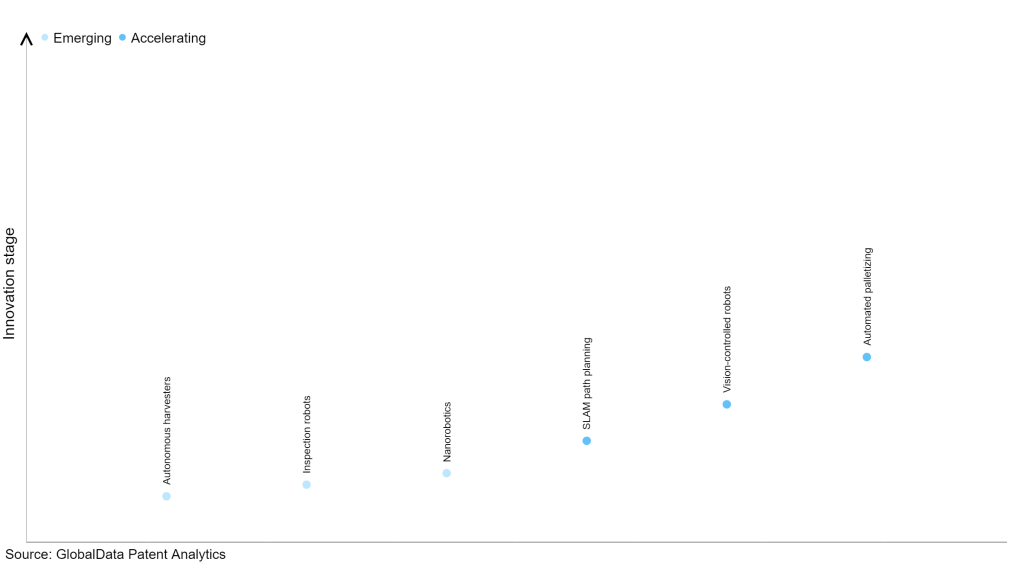The technology industry continues to be a hotbed of patent innovation. Activity is driven by the need for increased efficiency, precision, and speed in material handling processes across industries, and growing importance of technologies such as vision systems and machine learning algorithms, enabling robots to adapt to various shapes and sizes of objects. In the last three years alone, there have been over 1.5 million patents filed and granted in the technology industry, according to GlobalData’s report on Robotics in technology: automated palletizing. Buy the report here.

Access deeper industry intelligence
Experience unmatched clarity with a single platform that combines unique data, AI, and human expertise.
However, not all innovations are equal and nor do they follow a constant upward trend. Instead, their evolution takes the form of an S-shaped curve that reflects their typical lifecycle from early emergence to accelerating adoption, before finally stabilizing and reaching maturity.
Identifying where a particular innovation is on this journey, especially those that are in the emerging and accelerating stages, is essential for understanding their current level of adoption and the likely future trajectory and impact they will have.
185+ innovations will shape the technology industry
According to GlobalData’s Technology Foresights, which plots the S-curve for the technology industry using innovation intensity models built on over 1.6 million patents, there are 185+ innovation areas that will shape the future of the industry.
Within the emerging innovation stage, autonomous harvesters, inspection robots and nanorobotics are disruptive technologies that are in the early stages of application and should be tracked closely. SLAM path planning, vision-controlled robots, and automated palletizing are some of the accelerating innovation areas, where adoption has been steadily increasing.
Innovation S-curve for robotics in the technology industry

Automated palletizing is a key innovation area in robotics
Automated palletizing involves employing robots or automated machinery to neatly arrange and stack goods onto pallets, optimizing storage and transportation. These systems utilize sensors and specialized software to precisely position and stack products, diminishing reliance on manual labor and enhancing operational efficiency.
GlobalData’s analysis also uncovers the companies at the forefront of each innovation area and assesses the potential reach and impact of their patenting activity across different applications and geographies. According to GlobalData, there are 515+ companies, spanning technology vendors, established technology companies, and up-and-coming start-ups engaged in the development and application of automated palletizing.
Key players in automated palletizing – a disruptive innovation in the technology industry
‘Application diversity’ measures the number of applications identified for each patent. It broadly splits companies into either ‘niche’ or ‘diversified’ innovators.
‘Geographic reach’ refers to the number of countries each patent is registered in. It reflects the breadth of geographic application intended, ranging from ‘global’ to ‘local’.
Among the companies innovating in automated palletizing, Toshiba is one of the leading patents filers. The company’s patent describes logistics support device comprising a deriver and an instruction controller. The deriver conducts statistical analysis of environmental data regarding changes inside a storage unit when it is installed in a mobile unit and remains at a location where tasks are carried out on the stored items in a delivery operation. The instruction controller issues guidance based on the outcome of the statistical analysis conducted by the deriver when a storage unit housing items is installed in a mobile unit and the delivery of the items is underway. Other prominent patent filers in the space include Mujin and Panasonic.
In terms of application diversity, Mujin held the top position, while Toshiba and Daifuku stood in the second and third positions, respectively. By means of geographical reach, Azenta leads the pack, followed by AutoStore and Ocado Group.
Automated palletizing in robotics is pivotal in revolutionizing the logistics and manufacturing industries. It enhances operational efficiency by leveraging robots to precisely stack and organize goods on pallets, significantly reducing manual labor, increasing speed, and ensuring accuracy in material handling processes.
To further understand the key themes and technologies disrupting the technology industry, access GlobalData’s latest thematic research report on Robotics.
Data Insights
From

The gold standard of business intelligence.
Blending expert knowledge with cutting-edge technology, GlobalData’s unrivalled proprietary data will enable you to decode what’s happening in your market. You can make better informed decisions and gain a future-proof advantage over your competitors.







